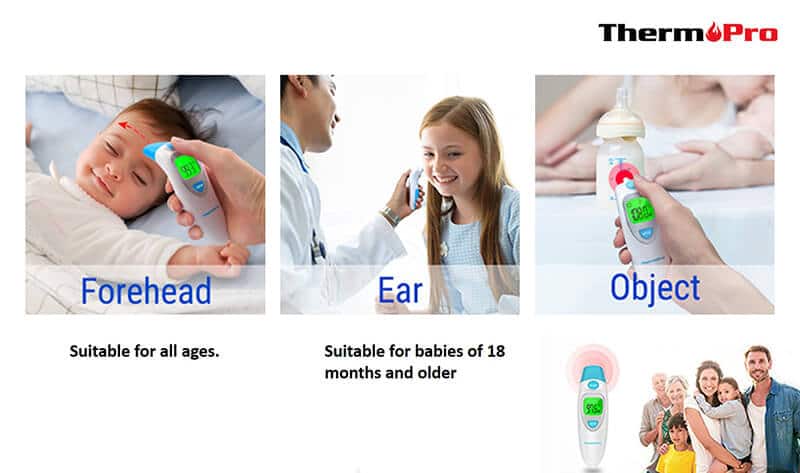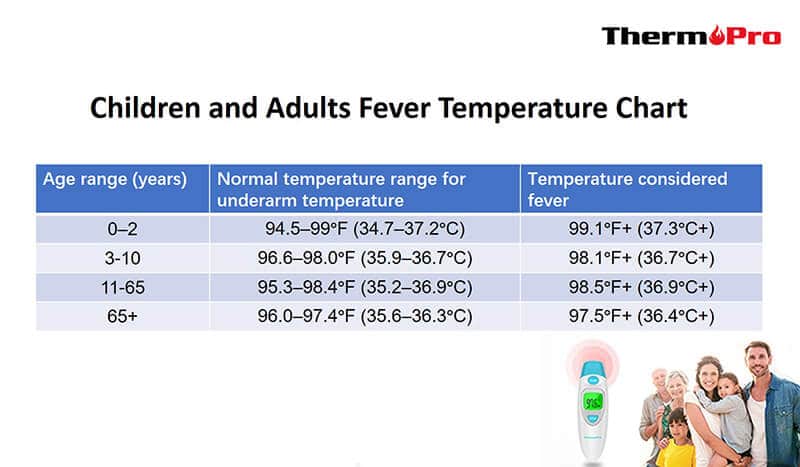The customer service team is always listening, taking notes, and quantifying complaints to ensure our products are continually improved. Due to selling directly to you, the customer, via Amazon, we can use product reviews to help us improve our existing products or help further development of new products.
Table of Contents
Cold and flu season is upon us, and every year it seems to get scarier and more pervasive. One of the best indicators that you may have an illness like the cold or flu, is a high fever temperature. So we’ve put together the ultimate guide on fever temperature in adults and children. Continue reading for your definitive source on what temperature is considered a fever for a child, an adult, or anyone else in your family with a suitable thermometer.
What is Fever?
Let’s first discuss what a fever is. According to, The Mayo Clinic, the definition of a fever is “a temporary increase in your body temperature, often due to an illness.” A fever is also defined as a body temperature over 100.4 F (38.0 C).
Symptoms and Causes of Fever
While a high fever temperature will usually go away within a few days, it’s important to monitor your body temperature and symptoms to know if you need to check in with your primary care provider.
According to the U.S. National Library of Medicine, fevers can be caused by heat illnesses, cancers, autoimmune disease, childhood immunizations, infections, and as a reaction to medicines like antibiotics, blood pressure medications and anti-seizure medications. Adults with fevers can suffer from symptoms like sweats and chills, headaches, body aches, weakness, restlessness, and a loss of appetite.
Symptoms in Infants and Children
Here are some common causes of fevers in children and infants: as a response to infection or injury, respiratory infections like cold and flu, gastroenteritis, and certain bacterial infections like ear infections and urinary tract infections. Common symptoms in infants and children are sweating, chills, muscle aches, loss of appetite, irritability, fatigue, and headaches.
Do you know what temperature is a fever for a child or infant? Keep reading to find out what constitutes a fever temperature Celsius and Fahrenheit.
You should contact your doctor if your infant is:
- 3 months or younger with a rectal temp of 100.4 F (38 C) or higher.
- 3-6 months with a rectal temp higher than 102 F (38.9 C), or has a rectal temp up to 102 F (38.9 C) and is exhibiting additional symptoms.
- 6-24 months with a rectal temp higher than 102 F (38.9 C) lasting more than one day without additional symptoms. If additional symptoms are present, you should consider contacting your doctor depending on how severe the symptoms are.
You should contact your doctor if your child has a high-temperature fever and:
- Has had a fever that has lasted longer than three days.
- Is unable to respond to your voice, eye contact or expressions.
- Is fatigued or unusually irritable, has a severe head or stomach ache, is vomiting repeatedly or is otherwise in discomfort.

Symptoms in Adults
If an adult’s temperature is 103 F (39.4 C) or higher, then you should seek medical attention. For high fever temperature adults, you should seek medical attention if in addition to a high fever temperature there are symptoms like:
- mental confusion or severe headache
- stiff neck or pain when the head is bent forward
- skin flushing, rash, or the feeling of “hot skin”
- convulsions or hallucinations
- aching muscles or body aches
Factors that Impact Normal Body Temperature
Your body temperature naturally fluctuates throughout the day depending on:
- time of day
- physical activity level
- gender
- age
- drug use
- tobacco use
- alcohol use
- meals
- stress level
Also, depending on how you measure your temperature, you can get several different readings at different times because there is no uniform temperature for the human body. Even smoking and eating can affect your body temperature.
Children and Adults Fever Temperature Chart
For now, here’s our version for your use:
How to Take Your Temperature?
There are several ways to take an adult’s, or a child’s temperature. The armpit method is pretty self-explanatory so we’re going to go into detail about how to take your temperature, or your child’s temperature, through the mouth (oral), ear (tympanic), and rectal methods.
Mouth
There are a variety of oral thermometers currently on the market but, for the most part, they all work the same way. Whether it’s the latest digital thermometers or a good old-fashioned glass thermometer, we can help you figure out how to take your temperature by mouth.
- Take the thermometer out of its case. Clean and dry it before use.
- With your mouth open, put the tip of the thermometer underneath your tongue.
- Gently close your lips around the thermometer while keeping it under your tongue.
- Keep the thermometer under your tongue until either your digital thermometer beeps or for 3 minutes with a glass thermometer.
- Remove the thermometer from your mouth without touching the tip.
- Check the digital or analog readout for your temperature.
- Clean the thermometer after using and return it to its holder.
Ear
The fastest and easiest way to take a child’s temperature is usually through the ear. If you aren’t familiar with how to use an ear thermometer on a child or adult, we’ll help walk you through it.
- Read any instructions that came with the thermometer.
- Take the thermometer out of its case and put a throw-away cover over the tip of the thermometer.
- Hold the person or child’s head so that they don’t move their head accidentally while you’re taking their temperature.
- For children, pull the ear straight back. For adults, pull the ear gently up and then back,
- Gently put the covered tip into the ear opening. Do not force the thermometer.
- Wait for the thermometer to beep while holding down the button.
- Remove the thermometer from the ear and read the temperature display
- Remove and discard the throw-away cover and put the thermometer back into its case.

Rectal
As with the methods previously discussed, the best way to know how to use your thermometer is by reading the instructions. But if you’ve lost them, or just don’t understand the way that they were written, then we have you covered. The directions below should work for whatever type of rectal thermometer you may have.
- Take the thermometer out of its case and clean it before use.
- Put water-soluble lubricant, water-based lubricant, or petroleum jelly on the thin, shiny end (or bulb end) of the thermometer.
- Lay the child or person down and spread the buttocks apart.
- Insert the bulb end into the rectal canal until the shiny metallic part of the thermometer is no longer visible, no more than 1 in.
- Hold the person or child down gently and keep the thermometer in place for up to a minute or until the thermometer beeps.
- Remove the thermometer and read the result.
- Clean and dry the thermometer.
- Put the thermometer back into its case.
Which Temperature Taking Method Should You Use?
When it comes to children, rectal temperatures are generally thought to be the most accurate. As for adults, using the tympanic method (right and left) is a high accuracy and acceptable precision way.
When it comes to adults and children, you should use the tympanic (ear) method of taking temperature, and stick with using the thermometer that you’re comfortable with and that has been approved for use by your child’s doctor.










